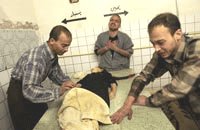Liberty and the Party of Lincoln
An Essay by Terence Lyons
As a lifelong Republican, surveying the present state of political affairs does make me ask – as others ask me from time to time – why I still count myself a member of the Grand Old Party. Surely the answer transcends one administration. Alas, it may have to transcend one generation. (And at some point, if things don’t change, it may transcend itself right into the ground.) And so, I formulate the answer – for myself as much as for anyone else – like this:
I had a college professor who would take one day each term – no matter what course he was teaching at the time – to deliver a lecture on the subject of liberalism. (I should state that I have always regarded liberalism as an American ideal, not the special property of any political party and certainly not a term of derision.) It was Professor Beilhartz’s thesis that liberalism was an emotion rather than an articulated political philosophy – an emotion expressed in the cry of the French Revolution: “Liberty, Equality, Fraternity!”
The fundamental difficulty with liberalism is that there is an inherent tension between liberty and equality – absolute liberty crushes equality, and absolute equality smothers liberty, and there is a continuum of tense struggles between the two at all points between the absolutes. (It is the function of fraternity – good will among men (make that persons) – to lubricate this tension, but the tension persists nevertheless.)
In my view, Republicans tend to favor liberty in the management of this tension, while Democrats tend to favor equality. Each party recognizes both elements of liberalism, and each party recognizes the necessity and benefits of the tension between the two, and it is that recognition that separates Republicans from Libertarians, and Democrats from Socialists.
The Republicans’ emphasis on liberty leads them to favor a limited government (that which governs least, governs best) and to view government as a defensive protector of private enterprise – the freedom that allows individuals to create progress. True Republican philosophy enthusiastically endorses the manifesto set down by John Steinbeck in East of Eden:
“Our species is the only creative species, and it has only one creative instrument, the individual mind and spirit of a man. . . . And this I believe: that the free, exploring mind of the individual human is the most valuable thing in the world. And this I would fight for: the freedom of the mind to take any direction it wishes, undirected. And this I must fight against: any idea, religion, or government which limits or destroys the individual.”The Democrats’ emphasis on equality, on the other hand, leads them to favor the broader government that is required for the maintenance of equality and to view government as the engine of progress. Thus, the Democrats’ agenda promotes “government programs” such as the New Deal or the Great Society.
It is certainly true that in today’s political landscape the two parties (and, I am sad to say, especially the Republicans) do not always hold true to such philosophical positions, choosing instead to cater to the special interests of what have become their respective “core constituencies.” But every now and then these political themes still assert themselves, as they did in this June’s Supreme Court decision in Kelo v. City of New London. In that case, the Court, in a 5-4 decision, upheld a Connecticut city’s condemnation of 15 residences for a commercial development project even though the condemned properties were not “blighted or otherwise in poor condition” and even though the taken land was to be used by private corporate parties rather than municipal facilities.
Several news commentators expressed surprise that Democrat-appointed Justices Ginsburg and Breyer voted in favor of the forced transfer to the private corporate interests while Republican-appointed Justices Rehnquist, Scalia, and Thomas voted for the less powerful homeowners. But to me, the alignment of the justices was consistent and predictable according to the higher standards of political philosophy rather than the lower standards of whose-ox-is-being-gored-today. The Democrats’ view that the use of the condemnation power as an engine for “economic revitalization” is “a traditional and long accepted function of government” triumphed (narrowly) over the Republicans’ view that the function of government is rather “to protect ‘the security of Property,’ which Alexander Hamilton described to the Philadelphia Convention as one of the ‘great obj[ects] of Gov[ernment].’”
Which brings me square-on to the subject of progress, mentioned above. The Republican Party is often accused of being stuck in the past and anti-progress. While some who call themselves Republicans (especially today) are surely guilty of this charge, it is not a fair indictment of real GOP principles. True party loyalists do tend to be students of history, but that is because such Republicans share the outlook of Patrick Henry: “I know of no way of judging the future but by the past.” Democrats may gaze upon the future and quote G. B. Shaw (as Robert Kennedy was fond of doing): “You see things; and you say, ‘Why?’ But I dream things that never were; and I say, ‘Why not?’” Republicans prefer to rely on George Santayana’s maxim that those who cannot remember the past are condemned to repeat it. But that does not divide the parties over whether to pursue progress, but only over how best to achieve it. It is instructive to read Mr. Santayana’s maxim in context:
“Progress, far from consisting in change, depends on retentiveness. When change is absolute there remains no being to improve and no direction is set for possible improvement: and when experience is not retained, as among savages, infancy is perpetual. Those who cannot remember the past are condemned to repeat it.”Republicans believe the past teaches that real progressive change is not wrought by government programs but by individual persons exercising their creative liberties under the protection of a government that insures their freedom to do so.
A friend recently called my attention to a piece written by Garrison Keillor (of Lake Wobegon fame) just before the 2004 elections:
“Something has gone seriously haywire with the Republican Party. Once, it was the party of pragmatic Main Street businessmen in steel-rimmed spectacles who decried profligacy and waste, were devoted to their communities and supported the sort of prosperity that raises all ships. . . . The genial Eisenhower was their man, a genuine American hero of D-Day, who made it OK for reasonable people to vote Republican. He brought the Korean War to a stalemate, produced the Interstate Highway System, declined to rescue the French colonial army in Vietnam, and gave us a period of peace and prosperity, in which (oddly) American arts and letters flourished and higher education burgeoned – and there was a degree of plain decency in the country.”Coming from a Democrat, I can almost buy that, as well as most of the criticism Mr. Keillor goes on to level at today’s Republican leadership – but not the “(oddly)” dig. Because arts and letters flourish best when individuals are guaranteed the liberty to extend themselves beyond equality, and that is true Republican policy in action. I do not know how this current batch of narrow-minded, salivating censors and intellectual bigots wormed their way into my Republican Party, and I certainly don’t like it one bit. The party of Lincoln and liberty would let Robert Mapplethorpe photograph whatever he wishes, and defend his right to exhibit it too; but don’t expect to have it funded with a government program.
I dream (Republicans do that, you know) of a presidential contest between a real Republican and a real Democrat – perhaps the John McCain / Bill Bradley match up we didn’t get in 2000 – in which all the voters know that both candidates fully participate in the tension of liberalism and both candidates seem to share the good will that lubricates that tension. I will walk into the polling booth, adjust my steel-rimmed spectacles, and probably vote for the Republican. Because, on such a landscape, I believe that when push comes to shove, liberty trumps equality.
And that is why I am a Republican. Still. So far.





